The rebel painter who ushered in a new era of Indian art
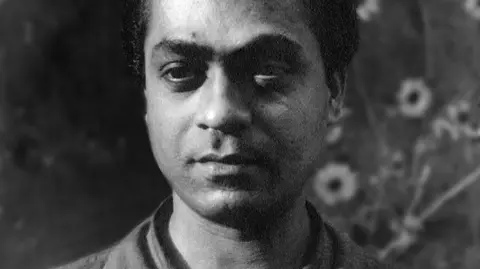 Chinha
ChinhaSome artists become legends in their lifetime yet remain a mystery years after their death.
Indian painter Vasudeo Santu Gaitonde, born 100 years ago on 2 November 1924, was one such master.
Considered one of South Asia's greatest abstract painters, Gaitonde was part of a rebellious generation of artists who laid the foundation for a new era of Indian art in the mid-20th Century.
He was deeply inspired by the techniques used by Western painters but his work remained rooted in Asian philosophy, infusing light and texture in ways that, admirers say, evokes a profound sense of calmness.
His paintings were meant to be "meditations on the light and universe", says Yamini Mehta, who worked as the international head of South Asian Art at Sotheby’s.
"The play of light and shadows and texture makes these paintings dynamic."
In a career that spanned decades, Gaitonde never pursued fame or fortune. But his works continue to grab attention at auctions, years after his death in 2001.
In 2022, an untitled oil painting by him fetched 420m rupees (nearly $5m; £3.9m), setting a new record for Indian art at that time. The bluish shades of the work reminded viewers of large expanses of the sea or sky.
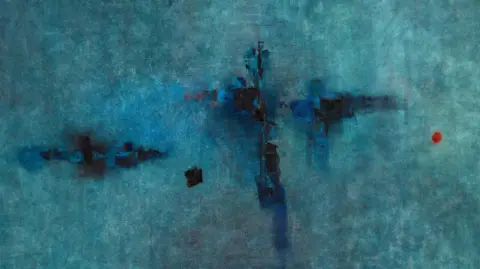 Saffronart
SaffronartGaitonde lived as a recluse for most of his life. He was deeply impacted by Japanese Zen philosophy and this meditative mindset was often reflected in his paintings.
“Everything starts from silence. The silence of the canvas. The silence of the painting knife. The painter starts by absorbing all these silences… Your entire being is working together with the brush, the painting knife, the canvas to absorb that silence and create,” he told journalist Pritish Nandy in a rare interview in 1991.
Originally from the western state of Goa, Gaitonde's family lived in Mumbai city (formerly Bombay) in a small, three-room dwelling in a chawl - an affordable tenement complex for the city’s working class.
A born artist, he joined Mumbai’s famous JJ School of Arts for training in 1946. Despite his father’s disapproval - art was not seen as a viable career in India at the time - Gaitonde funded his own studies and earned a diploma in 1948.
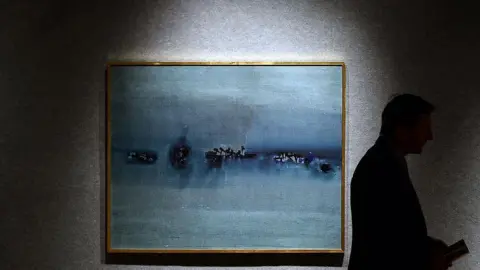 Getty Images
Getty ImagesFor some time, he was part of a group of influential Indian artists called the Progressive Artists Group, which was set up to encourage new forms of art. Formed in 1947 in Mumbai, the group counted leading artists such as Francis Souza, SH Raza, MF Husain and Bhanu Athaiya - the first Indian to win an Oscar - as its members.
Gaitonde also worked at the city's Bhulabhai Desai Memorial Institute, another hub frequented by legends such as sitarist Ravi Shankar and theatre artist Ebrahim Alkazi.
“This was an interesting time as Mumbai was a hotbed of creativity,” says artist and writer Satish Naik, who has published an anthology on Gaitonde in the Marathi language.
Indian art at that time was largely dominated by realism, found in the murals of the Ajanta caves and in Mughal art or miniature paintings.
“Gaitonde began with realistic works but soon sought a different path. He was one of the first ones to reject the form and adopt the formless,” Naik said.
"In that sense, he was a rebel. He wanted to paint as it pleased him, not as someone dictated to him."
Gaitonde's deep interest in spirituality helped him progress towards his craft.
"My paintings are nothing else but the reflection of nature," he once wrote in a 1963 questionnaire for New York's Museum of Modern Art.
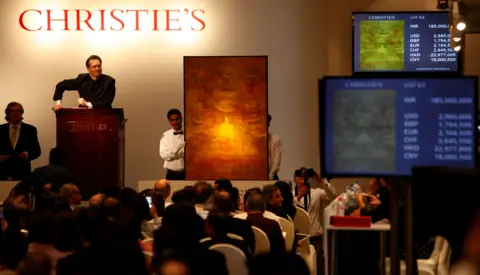 Getty Images
Getty ImagesIn 1963, Morris Graves, a famous abstract painter from the US, saw Gaitonde's work during a trip to India, and was heavily impressed.
He immediately sent a letter to Dan and Marian Johnson of the Willard Gallery in New York, describing him as "one of the finest" painters he had ever seen.
"He’s as fine - or superb - as Mark Rothko at his best and will be a world-known painter one of these days,” Graves wrote.
“He is an abstract painter with something unspeakably beautiful and clean. They are the most beautiful landscapes of the mind plus light.”
In 1964, Gaitonde moved to New York after getting the Rockefeller Fellowship. The next two years were a formative phase in his career as the young artist got a chance to meet American modern artists and see their works, which further developed his style.
In 1971, Gaitonde received the Padma Shri, the fourth-highest civilian award in India, for his outstanding contribution to art.
But despite his growing fame, he became increasingly withdrawn in the coming years.
His disciple and renowned artist Laxman Shreshtha recounts in Naik’s book how MF Husain would often try to visit Gaitonde at his Delhi residence.
“If Gaitonde didn’t want to meet anyone, he would not open the door, not even for Husain who would sketch something on the door and go. That was Husain’s way of saying 'I had dropped by'.”
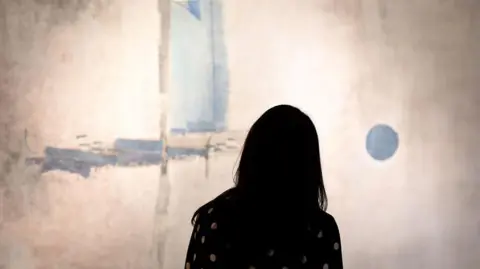 Getty Images
Getty ImagesEven his work underwent a shift. Usually, the artist would paint anywhere between six and seven canvases in a year. But after a spinal injury in 1984, the numbers went down considerably.
“I still continue to paint; I make paintings in my head. I now have limited energy which I need to conserve and cannot waste putting paint to canvas,” he once told art gallerist Dadiba Pundole.
As Gaitonde's stature as an artist grew, his paintings became fewer and rarer, all of which added to the charm and mystery surrounding his work.
It is perhaps also one of the reasons why his paintings command such high prices even today.
When Gaitonde died in 2001 at the age of 77, his death went widely unreported as the artist lived his last years in obscurity.
But his thought-provoking canvases continued to make waves around the world.
Cara Manes, an associate curator at the Museum of Modern Art, once said that Gaitonde’s works were an embodiment of what silence might look like. "And yet there’s a certain shimmering effect that emerges out of that silence which is then pitted against these very solid marks, assertive application of colours."
For the artist, though, art remained a deeply personal form of self-expression.
He often said: “I let the colours flow and watch. That is my painting.”
